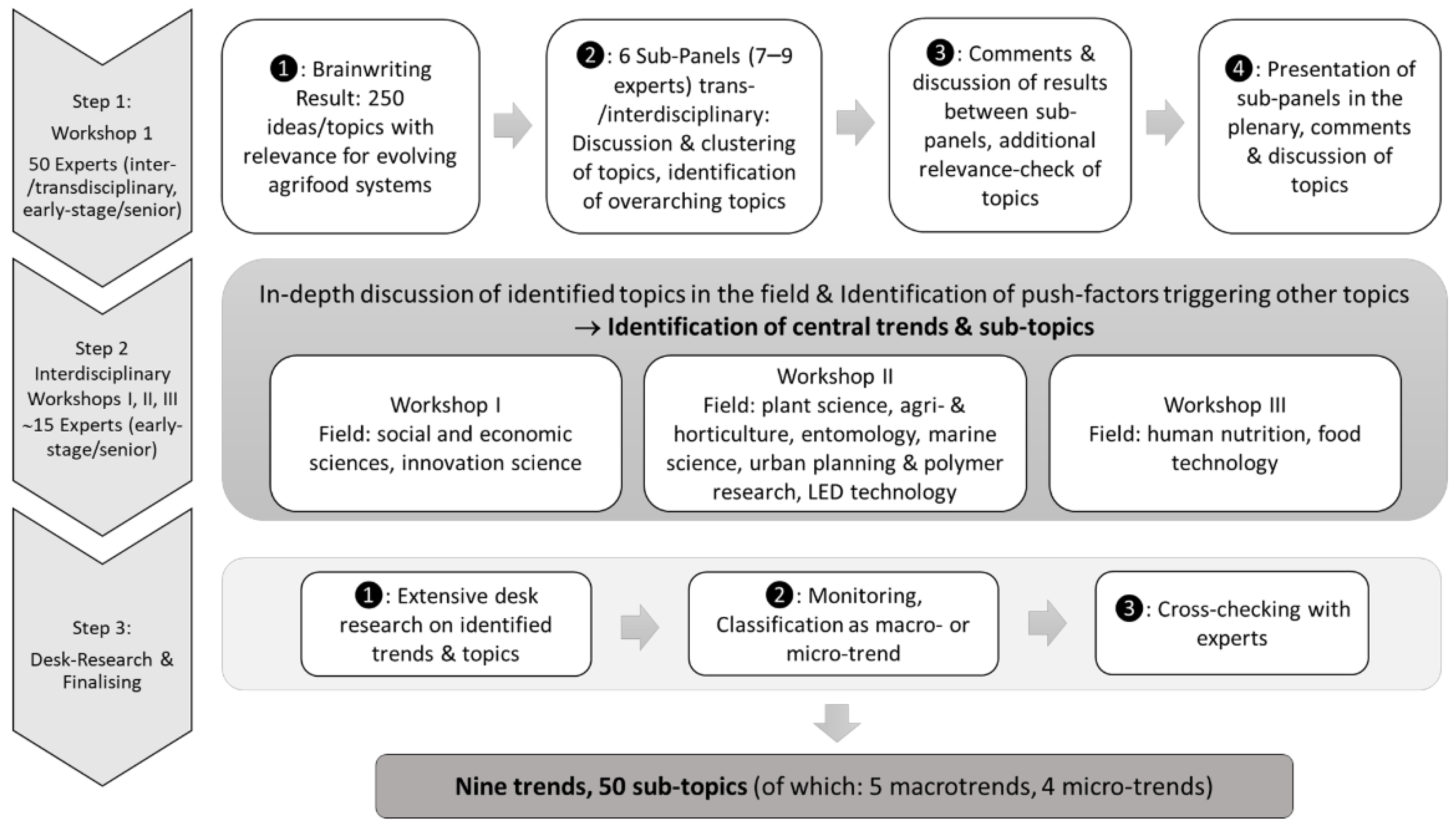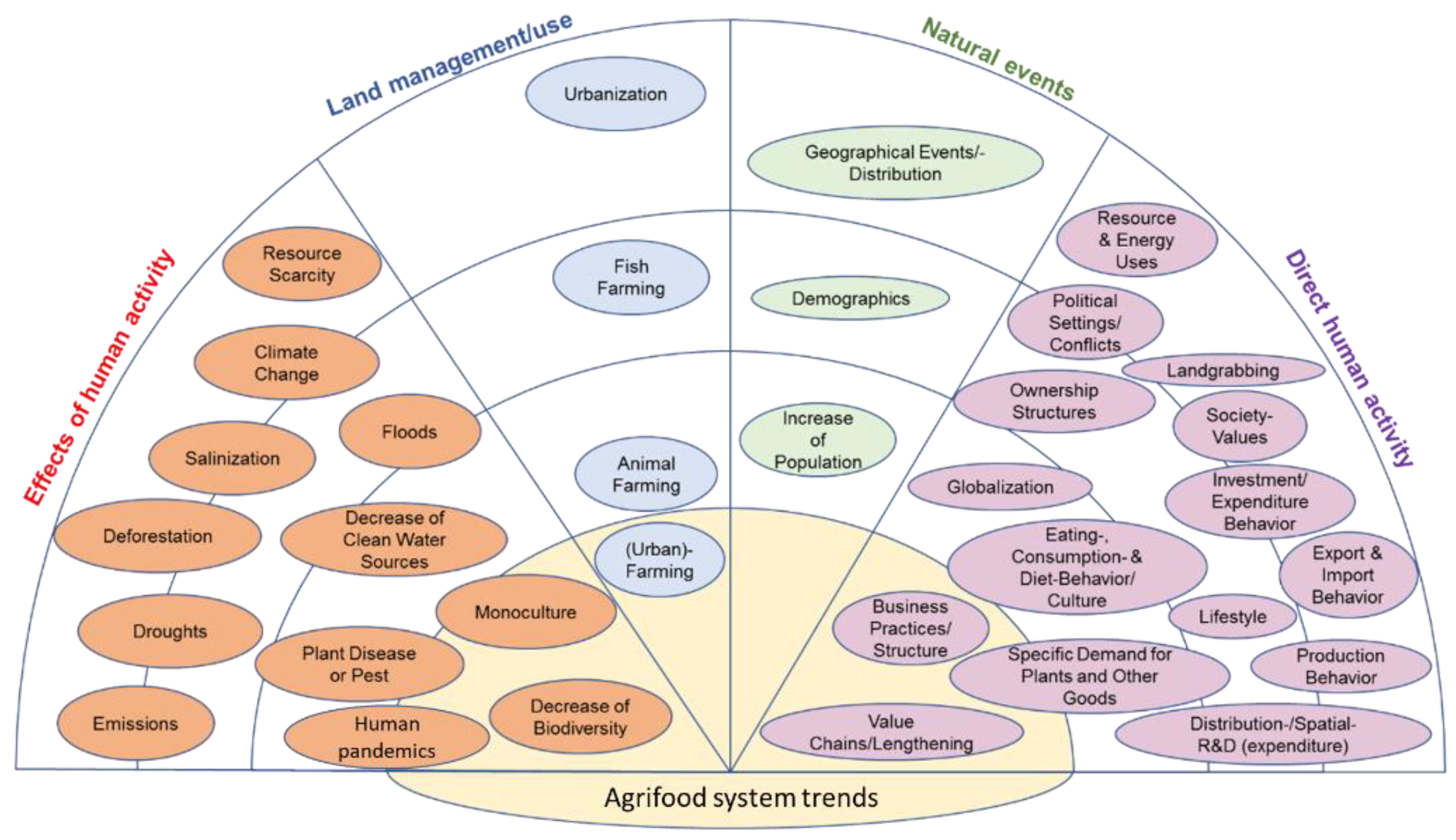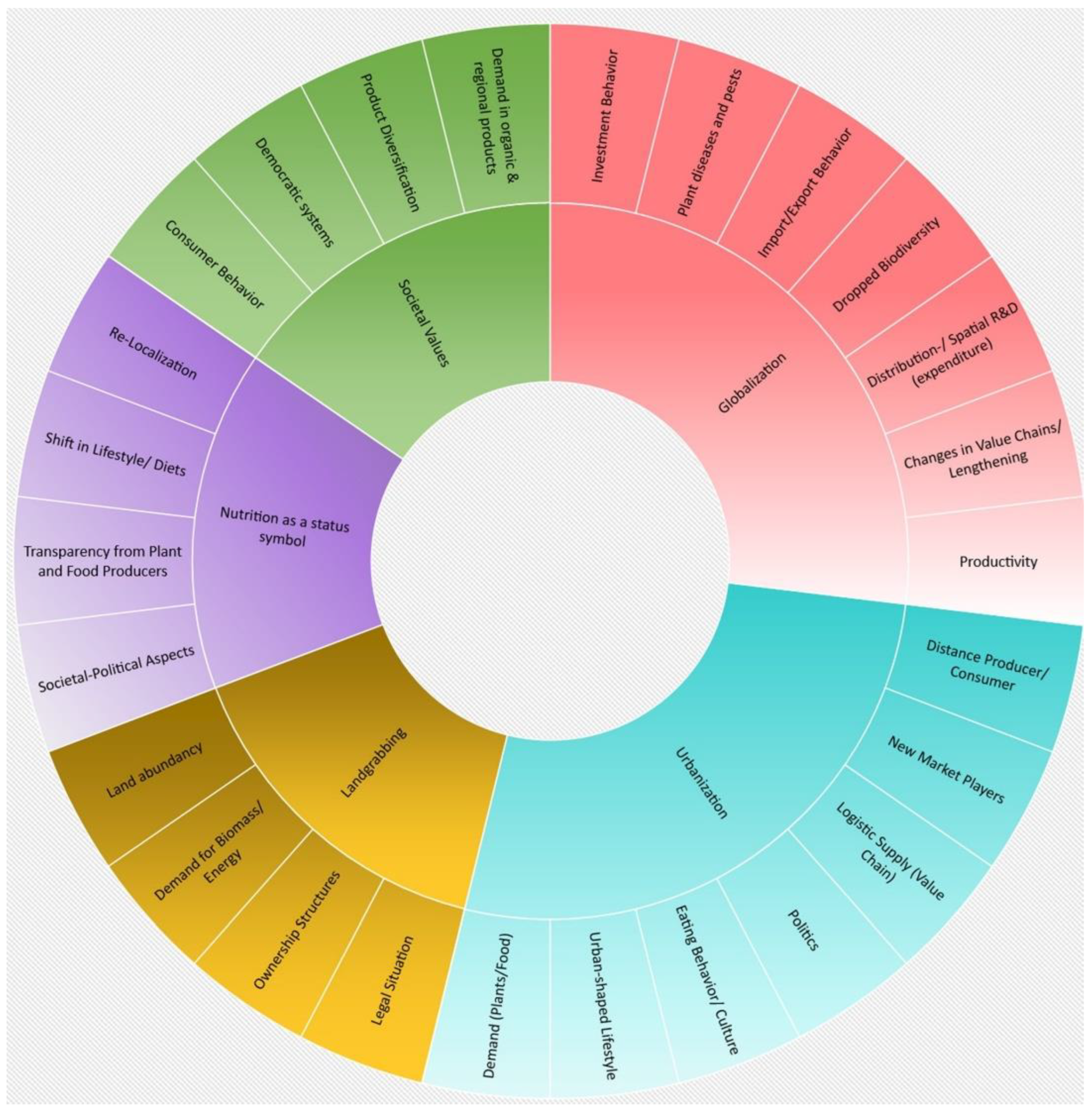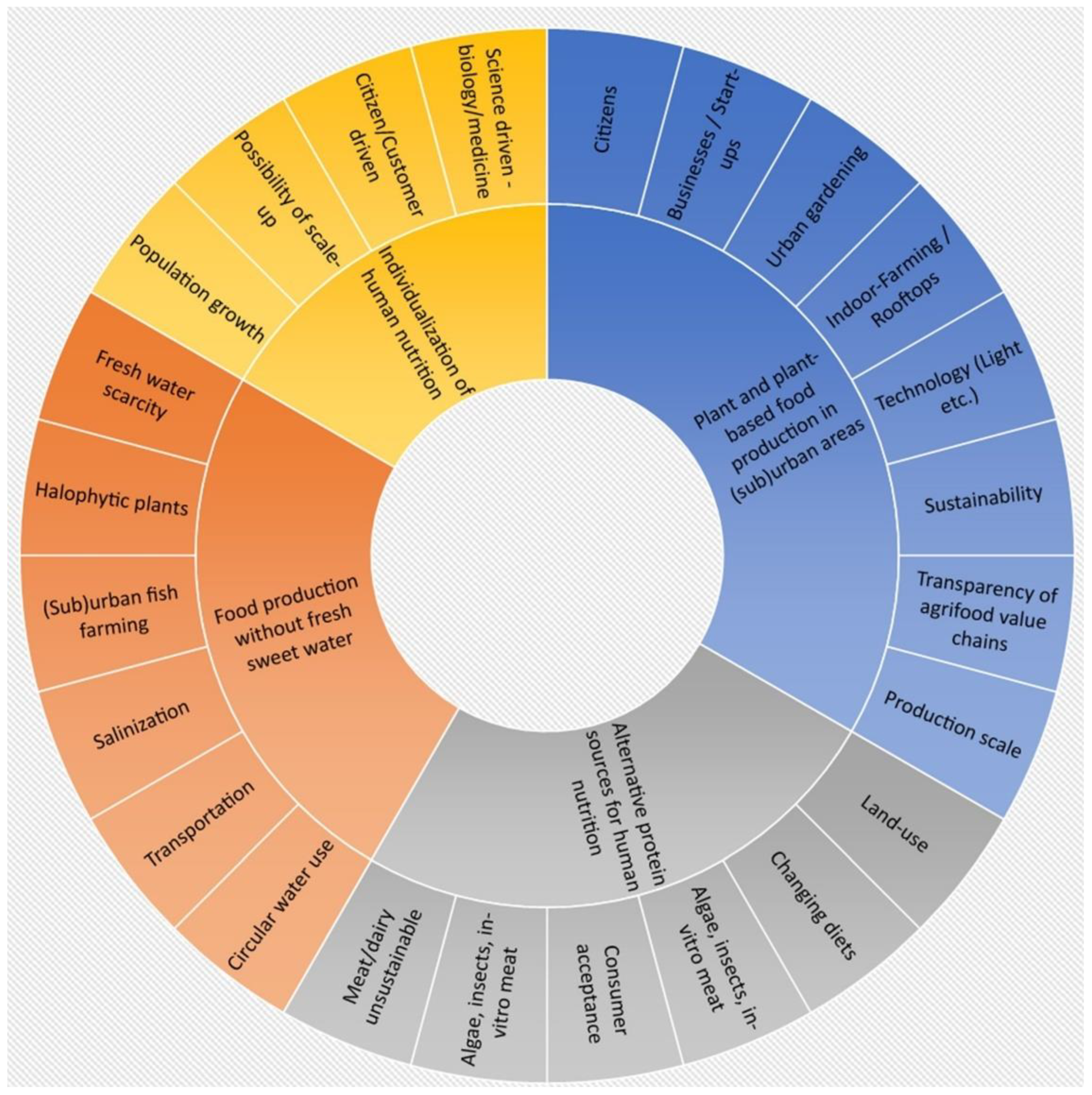Trends Shaping Western European Agrifood Systems of the Future
Abstract
1. Introduction
- Which current detectable trends will influence the future of Western European agrifood systems and hence, food security?
- Which trends are key drivers (macro trends) and which trends show strong influential potential (micro trends) for the future development of agrifood systems?
- What importance do those trends have for the strategic aims of research related to agrifood systems?
2. Materials and Methods
3. Results
3.1. Identification of Macro Trends
3.1.1. Urbanization
3.1.2. Globalization
3.1.3. Changes in Societal Values
3.1.4. Nutrition as Status Symbol
3.1.5. Land Grabbing
3.2. Identification of Micro-Trends
3.2.1. Plant and Plant-Based Food Production in (Sub)Urban Areas
3.2.2. Food Production without Fresh Sweet Water
3.2.3. Alternative Protein Sources for Human Nutrition
3.2.4. Individualization of Human Nutrition
4. Discussion
5. Conclusions
Author Contributions
Funding
Institutional Review Board Statement
Informed Consent Statement
Data Availability Statement
Acknowledgments
Conflicts of Interest
References
- United Nations Statistics Division. UNSD—Methodology. Available online: https://unstats.un.org/unsd/methodology/m49/ (accessed on 26 July 2022).
- Eurostat. Eurostat—Tables, Graphs and Maps Interface (TGM) Table. Available online: http://ec.europa.eu/eurostat/tgm/table.do?tab=table&init=1&language=de&pcode=tps00001&plugin=1 (accessed on 24 October 2021).
- Food and Agriculture Organization of the United Nations. The Future of Food and Agriculture: Trends and Challenges, 2nd ed.; Food and Agriculture Organization of the United Nations: Rome, Italy, 2017; ISBN 9789251095515. [Google Scholar]
- United Nations. Transforming Our World: The 2030 Agenda for Sustainable Development. 2015. Available online: https://sustainabledevelopment.un.org/content/documents/21252030%20Agenda%20for%20Sustainable%20Development%20web.pdf (accessed on 25 July 2022).
- Bennett, E.M.; Baird, J.; Baulch, H.; Chaplin-Kramer, R.; Fraser, E.; Loring, P.; Morrison, P.; Parrott, L.; Sherren, K.; Winkler, K.J.; et al. Ecosystem services and the resilience of agricultural landscapes. In The Future of Agricultural Landscapes, Part II; Elsevier: Amsterdam, The Netherlands, 2021; pp. 1–43. ISBN 9780128229798. [Google Scholar]
- El Bilali, H.; Callenius, C.; Strassner, C.; Probst, L. Food and nutrition security and sustainability transitions in food systems. Food Energy Secur. 2019, 8, e00154. [Google Scholar] [CrossRef]
- Gerten, D.; Heck, V.; Jägermeyr, J.; Bodirsky, B.L.; Fetzer, I.; Jalava, M.; Kummu, M.; Lucht, W.; Rockström, J.; Schaphoff, S.; et al. Feeding ten billion people is possible within four terrestrial planetary boundaries. Nat. Sustain. 2020, 3, 200–208. [Google Scholar] [CrossRef]
- Bodirsky, B.L.; Chen, D.M.-C.; Weindl, I.; Soergel, B.; Beier, F.; Molina Bacca, E.J.; Gaupp, F.; Popp, A.; Lotze-Campen, H. Integrating degrowth and efficiency perspectives enables an emission-neutral food system by 2100. Nat. Food 2022, 3, 341–348. [Google Scholar] [CrossRef]
- Borsellino, V.; Schimmenti, E.; El Bilali, H. Agri-Food Markets towards Sustainable Patterns. Sustainability 2020, 12, 2193. [Google Scholar] [CrossRef]
- Jurgilevich, A.; Birge, T.; Kentala-Lehtonen, J.; Korhonen-Kurki, K.; Pietikäinen, J.; Saikku, L.; Schösler, H. Transition towards Circular Economy in the Food System. Sustainability 2016, 8, 69. [Google Scholar] [CrossRef]
- Von Braun, J.; Afsana, K.; Fresco, L.O.; Hassan, M.; Torero, M. Food system concepts and definitions for science and political action. Nat. Food 2021, 2, 748–750. [Google Scholar] [CrossRef]
- FAO. The Future of Food and Agriculture: Alternative Pathways to 2050. 2018. Available online: http://www.fao.org/3/I8429EN/i8429en.pdf (accessed on 28 July 2022).
- Martin, B.R. Foresight in science and technology. Technol. Anal. Strateg. Manag. 1995, 7, 139–168. [Google Scholar] [CrossRef]
- Rutting, L.; Vervoort, J.; Mees, H.; Driessen, P. Strengthening foresight for governance of social-ecological systems: An interdisciplinary perspective. Futures 2022, 141, 102988. [Google Scholar] [CrossRef]
- Stokols, D.; Fuqua, J.; Gress, J.; Harvey, R.; Phillips, K.; Baezconde-Garbanati, L.; Unger, J.; Palmer, P.; Clark, M.A.; Colby, S.M.; et al. Evaluating transdisciplinary science. Nicotine Tob. Res. 2003, 5, 21–39. [Google Scholar] [CrossRef]
- Heslin, P.A. Better than brainstorming? Potential contextual boundary conditions to brainwriting for idea generation in organizations. J. Occup. Organ. Psychol. 2009, 82, 129–145. [Google Scholar] [CrossRef]
- Vaseashta, A. Advanced sciences convergence based methods for surveillance of emerging trends in science, technology, and intelligence. Foresight 2014, 16, 17–36. [Google Scholar] [CrossRef]
- Penn, M.J.; Zalesne, E.K. Microtrends: The Small Forces Behind Tomorrow’s Big Changes, 1st edition; Twelve: New York, NY, USA, 2007; ISBN 9780446580960. [Google Scholar]
- United Nations. New Urban Agenda. 2017. Available online: http://habitat3.org/wp-content/uploads/NUA-English.pdf (accessed on 24 July 2022).
- FAO. The Future of Food and Agriculture: Trends and Challenges. 2017. Available online: http://www.fao.org/3/a-i6583e.pdf (accessed on 27 July 2022).
- UN DESA. World Urbanization Prospects: The 2018 Revision. 2019. Available online: https://www.un-ilibrary.org/content/books/9789210043144 (accessed on 27 July 2022).
- Antrop, M. Landscape change and the urbanization process in Europe. Landsc. Urban Plan. 2004, 67, 9–26. [Google Scholar] [CrossRef]
- Porkka, M.; Kummu, M.; Siebert, S.; Varis, O. From food insufficiency towards trade dependency: A historical analysis of global food availability. PLoS ONE 2013, 8, e82714. [Google Scholar] [CrossRef]
- Mergenthaler, M.; Wolfram, J.; Kothe, C.; Brümmer, N. Medien-Frames in der Berichterstattung über landwirtschaftliche Tierhaltung. Ber. Über Landwirtsch.—Z. Für Agrarpolit. Und Landwirtsch. Aktuelle Beiträge 2021, 99, 1–47. [Google Scholar] [CrossRef]
- Rovers, A.; Christoph-Schulz, I.; Brümmer, N.; Saggau, D. Trust no One? Citizens’ Concerns regarding the Pork and Dairy Supply Chain. Proc. Food Syst. Dyn. Proc. Syst. Dyn. Innov. Food Netw. 2017, 87–93. [Google Scholar] [CrossRef]
- Williams, J.; Martin, P. Defending the Social Licence of Farming: Issues, Challenges and New Directions for Agriculture; CSIRO Publishing: Melbourne, Australia, 2011; ISBN 9780643101593. [Google Scholar]
- Alexandratos, N.; Bruinsma, J. World Agriculture towards 2030/2050: The 2012 Revision. 2012. Available online: https://ageconsearch.umn.edu/record/288998 (accessed on 24 July 2022).
- Verburg, R.; Stehfest, E.; Woltjer, G.; Eickhout, B. The effect of agricultural trade liberalisation on land-use related greenhouse gas emissions. Glob. Environ. Change 2009, 19, 434–446. [Google Scholar] [CrossRef]
- Serraj, R.; Pingali, P. Agriculture & Food Systems to 2050: Global Trends, Challenges and Opportunities; World Scientific Publishing Co., Pte Ltd.: Singapore, 2018; ISBN 978-981-327-834-9. [Google Scholar]
- Bundesministerium für Ernährung und Landwirtschaft. Available online: https://www.bmel.de/SharedDocs/Downloads/DE/Broschueren/Agrarexporte2017.pdf?__blob=publicationFile&v=2 (accessed on 28 July 2022).
- Fuchs, R.; Alexander, P.; Brown, C.; Cossar, F.; Henry, R.C.; Rounsevell, M. Why the US-China trade war spells disaster for the Amazon. Nature 2019, 567, 451–454. [Google Scholar] [CrossRef]
- Nygard, B.; Storstad, O. De-globalization of Food Markets? Consumer Perceptions of Safe Food: The Case of Norway. Eur. Soc. Rural Sociol. 2002, 38, 35–53. [Google Scholar] [CrossRef]
- Bruinsma, J. World Agriculture: Towards 2015/2030: An FAO Perspective, 1st ed.; Routledge: London, UK, 2003; ISBN 9781315083858. [Google Scholar]
- Kijek, T.; Nowak, A.; Domańska, K. The Role of Knowledge Capital in Total Factor Productivity Changes: The Case of Agriculture in EU Countries. Ger. J. Agric. Econ. 2016, 65, 171–181. [Google Scholar] [CrossRef]
- US Agtech: A Bright Future—Investment in the Thriving Industry is on Track to Reach. 2017. Available online: https://files.pitchbook.com/website/files/pdf/Updated_agtech_graphic.pdf (accessed on 28 July 2022).
- AgTech-Q3 2021 VC Update. 2021. Available online: https://pitchbook.com/news/reports/q3-2021-emerging-tech-research-agtech (accessed on 24 July 2022).
- Crunchbase. Why VC Investors Are Plowing Record Sums into Agtech. Available online: https://news.crunchbase.com/news/agtech-startups-vc-funding-data/ (accessed on 2 May 2022).
- GV. Portfolio. Available online: https://www.gv.com/portfolio/ (accessed on 23 July 2022).
- AgFunder Agri-FoodTech Investing Report. 2019. Available online: https://agfunder.com/research/agfunder-agrifood-tech-investing-report-2019/ (accessed on 3 May 2022).
- Schwienbacher, A. Venture capital investment practices in Europe and the United States. Financ. Mark. Portf. Manag. 2008, 22, 195–217. [Google Scholar] [CrossRef]
- Emiko, T. Investment in Agritech Declines as Appetite for Food Delivery Wanes. 2020. Available online: https://www.ft.com/content/88360cd4-5731-11ea-abe5-8e03987b7b20 (accessed on 27 July 2022).
- European Commission. The EU Budget at a Glance. 2019. Available online: https://ec.europa.eu/info/sites/info/files/about_the_european_commission/eu_budget/budget-brochure-a5-17-05_interactive.pdf (accessed on 4 May 2022).
- EPRS. EU Agricultural Research and Innovation. 2019. Available online: https://www.europarl.europa.eu/RegData/etudes/BRIE/2019/630358/EPRS_BRI(2019)630358_EN.pdf (accessed on 2 May 2022).
- Greenvillei, J.; Kawasakii, K.; Jouanjeani, M.-A. OECD Food, Agriculture and Fisheries Papers. 2019. Available online: https://www.oecd-ilibrary.org/agriculture-and-food/dynamic-changes-and-effects-of-agro-food-gvcs_43b7bcec-en (accessed on 2 May 2022).
- Pardey, P.G.; Chan-Kang, C.; Dehmer, S.P.; Beddow, J.M. Agricultural R&D is on the move. Nature 2016, 537, 301–303. [Google Scholar] [CrossRef] [PubMed]
- Searchinger, T.; Hanson, C.; Ranganathan, J.; Lipinski, B.; Waite, R.; Winterbottom, R.; Dinshaw, A.; Heimlich, R. Creating a Sustainable Food Future: A menu of solutions to sustainably feed more than 9 billion people by 2050. In World Resources Report 2013–14; World Resources Institute: Washington, DC, USA, 2014; p. 13. [Google Scholar]
- Menker, S. A global food crisis may be less than a decade away: How Can We Avoid A Food Crisis That’s Less Than A Decade Away. Available online: https://gro-intelligence.com/insights/214-trillion-calories (accessed on 21 July 2022).
- Punja, Z.K.; de Boer, S.H.; Sanfaçon, H. Biotechnology and Plant Disease Management; CABI: Cambridge, MA, USA, 2007; ISBN 9781845932886. [Google Scholar]
- Boonekamp, P.M. Are plant diseases too much ignored in the climate change debate? Eur. J. Plant Pathol. 2012, 133, 291–294. [Google Scholar] [CrossRef]
- Nat Microbiol. Stop neglecting fungi. Nat. Microbiol. 2017, 2, 17120. [Google Scholar] [CrossRef] [PubMed]
- McKenna, M. Antibiotics set to flood Florida’s troubled orange orchards. Nature 2019, 567, 302–303. [Google Scholar] [CrossRef]
- Lewis, C.M.; Persoons, A.; Bebber, D.P.; Kigathi, R.N.; Maintz, J.; Findlay, K.; Bueno-Sancho, V.; Corredor-Moreno, P.; Harrington, S.A.; Kangara, N.; et al. Potential for re-emergence of wheat stem rust in the United Kingdom. Commun. Biol. 2018, 1, 13. [Google Scholar] [CrossRef]
- Butler, D. Fungus threatens top banana. Nature 2013, 504, 195–196. [Google Scholar] [CrossRef]
- Bebber, D.P.; Holmes, T.; Gurr, S.J. The global spread of crop pests and pathogens. Glob. Ecol. Biogeogr. 2014, 23, 1398–1407. [Google Scholar] [CrossRef]
- Poore, J.; Nemecek, T. Reducing food’s environmental impacts through producers and consumers. Science 2018, 360, 987–992. [Google Scholar] [CrossRef]
- Springmann, M.; Clark, M.; Mason-D’Croz, D.; Wiebe, K.; Bodirsky, B.L.; Lassaletta, L.; de Vries, W.; Vermeulen, S.J.; Herrero, M.; Carlson, K.M.; et al. Options for keeping the food system within environmental limits. Nature 2018, 562, 519–525. [Google Scholar] [CrossRef]
- Jackson, P.; Candel, J.; Davies, A.; de Vries, H.; Derani, C.; Dragović-Uzelac, V.; Hoel, A.H.; Holm, L.; Morone, P.; Penker, M.; et al. A Sustainable Food System for the European Union; Version 1.2; SAPEA: Berlin, Germany, 2021; ISBN 978-3-9820301-7-3. [Google Scholar]
- De Olde, E.M.; Valentinov, V. The Moral Complexity of Agriculture: A Challenge for Corporate Social Responsibility. J. Agric. Environ. Ethics 2019, 32, 413–430. [Google Scholar] [CrossRef]
- EIT Food. COVID-19 Impact on Consumer Food Behaviours in Europe: COVID-19 STUDY: European Food Behaviours. 2020. Available online: https://eit.europa.eu/library/study-covid-19-impact-consumer-food-behaviours-europe (accessed on 24 July 2022).
- Bund Ökologische Lebensmittelwirtschaft BÖLW. Umsatz Mit Bio-Lebensmitteln in Deutschland in den Jahren 2000 bis 2019. Available online: https://de.statista.com/statistik/daten/studie/4109/umfrage/bio-lebensmittel-umsatz-zeitreihe/ (accessed on 2 May 2022).
- Deutscher Innovationsreport Food 2021. Available online: https://www.researchgate.net/publication/356493861_Deutscher_Innovationsreport_Food_2021?channel=doi&linkId=619e11cd4fe4ea1cea97e683&showFulltext=true (accessed on 28 July 2022).
- Fernow, H.; Hauser, M.; Huber, B. Values & Visions 2030: Was uns Morgen Wichtig Ist; G.I.M. Gesellschaft für innovative Marktforschung mbH: Heidelberg, Germany, 2017; ISBN 978-3-00-056865-7. [Google Scholar]
- Bundesministerium für Umwelt, Naturschutz und Nukleare Sicherheit. Zukunft? Jugend Fragen!: Nachhaltigkeit, Politik, Engagement—Eine Studie zu Einstellungen und Alltag Junger Menschen. 2018. Available online: https://www.bmu.de/fileadmin/Daten_BMU/Pools/Broschueren/jugendstudie_bf.pdf (accessed on 23 April 2020).
- Astill, J.; Dara, R.A.; Campbell, M.; Farber, J.M.; Fraser, E.D.; Sharif, S.; Yada, R.Y. Transparency in food supply chains: A review of enabling technology solutions. Trends Food Sci. Technol. 2019, 91, 240–247. [Google Scholar] [CrossRef]
- Sustainability Report 2020. Available online: https://gik.media/wp-content/uploads/2021/01/2021-01-07-GIK-Sustainabiliy-Report.pdf (accessed on 28 July 2022).
- Willett, W.; Rockström, J.; Loken, B.; Springmann, M.; Lang, T.; Vermeulen, S.; Garnett, T.; Tilman, D.; DeClerck, F.; Wood, A.; et al. Food in the Anthropocene: The EAT–Lancet Commission on healthy diets from sustainable food systems. Lancet 2019, 393, 447–492. [Google Scholar] [CrossRef]
- Mertens, E.; Peñalvo, J.L. The Burden of Malnutrition and Fatal COVID-19: A Global Burden of Disease Analysis. Front. Nutr. 2020, 7, 619850. [Google Scholar] [CrossRef]
- Swinburn, B.A.; Kraak, V.I.; Allender, S.; Atkins, V.J.; Baker, P.I.; Bogard, J.R.; Brinsden, H.; Calvillo, A.; de Schutter, O.; Devarajan, R.; et al. The Global Syndemic of Obesity, Undernutrition, and Climate Change: The Lancet Commission report. Lancet 2019, 393, 791–846. [Google Scholar] [CrossRef]
- WHO. The Double Burden of Malnutrition: Policy Brief; WHO: Geneva, Swizterland, 2017. [Google Scholar]
- Popkin, B.M.; Corvalan, C.; Grummer-Strawn, L.M. Dynamics of the double burden of malnutrition and the changing nutrition reality. Lancet 2020, 395, 65–74. [Google Scholar] [CrossRef]
- Hawkes, C.; Ruel, M.T.; Salm, L.; Sinclair, B.; Branca, F. Double-duty actions: Seizing programme and policy opportunities to address malnutrition in all its forms. Lancet 2020, 395, 142–155. [Google Scholar] [CrossRef]
- Development Initiatives. Global Nutrition Report: The State of Global Nutrition. 2021. Available online: https://globalnutritionreport.org/documents/753/2021_Global_Nutrition_Report.pdf (accessed on 24 July 2022).
- Coscieme, L.; Pulselli, F.M.; Niccolucci, V.; Patrizi, N.; Sutton, P.C. Accounting for “land-grabbing” from a biocapacity viewpoint. Sci. Total Environ. 2016, 539, 551–559. [Google Scholar] [CrossRef]
- Smaller, C.; Mann, H. A Thirst for Distant Lands: Foreign Investment in Agricultural Land and Water. 2009. Available online: https://www.iisd.org/pdf/2009/thirst_for_distant_lands.pdf (accessed on 12 October 2021).
- Woertz, E.; Pradhan, S.; Biberovic, N.; Koch, C. Food Inflation in the GCC Countries. 2008. Available online: https://www.files.ethz.ch/isn/111316/food_inflation_3609.pdf (accessed on 18 October 2021).
- Sustainable Development Innovation Briefs No. 8. 2010. Available online: https://sustainabledevelopment.un.org/content/documents/no8.pdf (accessed on 24 July 2022).
- Cotula, L.; Vermeulen, S. Deal or no deal: The outlook for agricultural land investment in Africa. Int. Aff. 2009, 85, 1233–1247. [Google Scholar] [CrossRef]
- Ben Hassen, T.; El Bilali, H. Food Security in the Gulf Cooperation Council Countries: Challenges and Prospects. J. Food Secur. 2019, 7, 159–169. [Google Scholar] [CrossRef]
- Statistisches Bundesamt. Fachserie 3 Reihe 2.4-Kaufwerte für landwirtschaftliche Grundstücke. 2020. Available online: https://www.destatis.de/DE/Themen/Wirtschaft/Preise/Baupreise-Immobilienpreisindex/Publikationen/Downloads-Bau-und-Immobilienpreisindex/kaufwerte-landwirtschaftliche-grundstuecke-2030240207004.pdf?__blob=publicationFile (accessed on 13 October 2021).
- Zagema, B. Land and Power: The Growing Scandal Surrounding the New Wave of Investments in Land; Oxfam International: Oxford, England, 2011; ISBN 9781848149472. [Google Scholar]
- Anseeuw, W.; Boche, M.; Breu, T.; Giger, M.; Lay, J.; Messerli, P.; Nolte, K. Transnational Land Deals for Agriculture in the Global South: Analytical Report Based on the Land Matrix Database; CDE: Bern, Switzerland; CIRAD: Montpellier, France; GIGA: Hamburg, Germany, 2012; ISBN 978-92-95093-71-3. [Google Scholar]
- Urban Agriculture Europe; Lohrberg, F., Lička, L., Scazzosi, L., Timpe, A., Eds.; Jovis: Berlin, Germany, 2016; ISBN 9783868593716. [Google Scholar]
- Urban and Peri-Urban Agriculture in the EU 978-92-846-2953-4. 2018. Available online: http://www.europarl.europa.eu/RegData/etudes/STUD/2018/617468/IPOL_STU(2018)617468_EN.pdf (accessed on 24 July 2022).
- Pray, C.E.; Fuglie, K.O. Agricultural Research by the Private Sector. Annu. Rev. Resour. Econ. 2015, 7, 399–424. [Google Scholar] [CrossRef]
- Tefft, J.; Jonasova, M.; Adjao, R.; Morgan, A. Food Systems for An Urbanizing World. 2017. Available online: http://documents.worldbank.org/curated/en/454961511210702794/pdf/Food-Systems-for-an-Urbanizing-World.pdf (accessed on 19 October 2021).
- FAO. Agribusiness, Value Chains and the Rapid Transformation of Agrifood Systems. 2017. Available online: http://www.fao.org/3/a-i6811e.pdf (accessed on 18 October 2021).
- Reardon, T.; Echeverria, R.; Berdegué, J.; Minten, B.; Liverpool-Tasie, S.; Tschirley, D.; Zilberman, D. Rapid transformation of food systems in developing regions: Highlighting the role of agricultural research & innovations. Agric. Syst. 2019, 172, 47–59. [Google Scholar] [CrossRef]
- COST-Action Urban Agriculture Europe. Online Atlas. Available online: http://www.urban-agriculture-europe.org/online-atlas.html (accessed on 18 October 2021).
- ETC. Annotated Bibliography on Urban Agriculture. 2001. Available online: http://www.gewamed.net/share/img_documents/25_res_agr1.pdf (accessed on 18 October 2021).
- Pimbert, M.; Shindelar, R.; Schösler, H. Think Global, Eat Local: Exploring Foodways. 2015. Available online: https://www.environmentandsociety.org/perspectives/2015/1/think-global-eat-local-exploring-foodways (accessed on 23 July 2022).
- FAO. Fighting Poverty and Hunger: What Role for Urban Agriculture? 2010. Available online: http://www.fao.org/3/al377e/al377e00.pdf (accessed on 24 July 2022).
- McEldowney, J. Urban Agriculture in Europe: Patterns, Challenges and Policies: In-Depth Analysis. 2018. Available online: https://www.europarl.europa.eu/RegData/etudes/IDAN/2017/614641/EPRS_IDA(2017)614641_EN.pdf (accessed on 18 October 2021).
- ZALF. Research for AGRI Committee: Urban and Peri-Urban Agriculture in the EU. 2018. Available online: https://www.europarl.europa.eu/RegData/etudes/STUD/2018/617468/IPOL_STU(2018)617468_EN.pdf (accessed on 24 July 2022).
- Buehler, D.; Junge, R. Global Trends and Current Status of Commercial Urban Rooftop Farming. Sustainability 2016, 8, 1108. [Google Scholar] [CrossRef]
- Su, Y.-L.; Ow, D.W. Commercial Potential for Rooftop Farming in a Major City in China. In New Forms of Urban Agriculture: An Urban Ecology Perspective, 1st ed.; Diehl, J.A., Kaur, H., Eds.; Imprint Springer: Singapore, 2021; pp. 57–72. ISBN 978-981-16-3737-7. [Google Scholar]
- Yahya, N. Agricultural 4.0: Its Implementation Toward Future Sustainability. In Green Urea: For Future Sustainability; Yahya, N., Ed.; Springer: Singapore, 2018; pp. 125–145. ISBN 978-981-10-7577-3. [Google Scholar]
- Schreiner, M.; Mewis, I.; Neugart, S.; Zrenner, R.; Glaab, J.; Wiesner, M.; Jansen, M.A.K. UV-B Elicitation of Secondary Plant Metabolites. In III-Nitride Ultraviolet Emitters: Technology and Applications; Kneissl, M., Ed.; Springer International Publishing: Cham, Switzerland, 2015; pp. 387–414. ISBN 978-3-319-24100-5. [Google Scholar]
- Petrovics, D.; Giezen, M. Planning for sustainable urban food systems: An analysis of the up-scaling potential of vertical farming. J. Environ. Plan. Manag. 2022, 65, 785–808. [Google Scholar] [CrossRef]
- Edmondson, J.L.; Cunningham, H.; Densley Tingley, D.O.; Dobson, M.C.; Grafius, D.R.; Leake, J.R.; McHugh, N.; Nickles, J.; Phoenix, G.K.; Ryan, A.J.; et al. The hidden potential of urban horticulture. Nat. Food 2020, 1, 155–159. [Google Scholar] [CrossRef]
- Hasanuzzaman, M.; Shabala, S.; Fujita, M. (Eds.) Halophytes and Climate Change: Adaptive Mechanisms and Potential Uses; CABI: Wallingford, UK, 2019; ISBN 9781786394330. [Google Scholar]
- Rozema, J.; Flowers, T. Ecology. Crops for a salinized world. Science 2008, 322, 1478–1480. [Google Scholar] [CrossRef] [PubMed]
- Fitzner, M.; Fricke, A.; Schreiner, M.; Baldermann, S. Utilization of Regional Natural Brines for the Indoor Cultivation of Salicornia europaea. Sustainability 2021, 13, 12105. [Google Scholar] [CrossRef]
- Ahmed, N.; Turchini, G.M. Recirculating aquaculture systems (RAS): Environmental solution and climate change adaptation. J. Clean. Prod. 2021, 297, 126604. [Google Scholar] [CrossRef]
- Kumar, V.; Jaiswal, K.K.; Verma, M.; Vlaskin, M.S.; Nanda, M.; Chauhan, P.K.; Singh, A.; Kim, H. Algae-based sustainable approach for simultaneous removal of micropollutants, and bacteria from urban wastewater and its real-time reuse for aquaculture. Sci. Total Environ. 2021, 774, 145556. [Google Scholar] [CrossRef]
- Villarroel, M.; Junge, R.; Komives, T.; König, B.; Plaza, I.; Bittsánszky, A.; Joly, A. Survey of Aquaponics in Europe. Water 2016, 8, 468. [Google Scholar] [CrossRef]
- What is the Safe Operating Space for EU Livestock? Available online: https://risefoundation.eu/wp-content/uploads/2020/07/2018_RISE_Livestock_Full.pdf (accessed on 27 July 2022).
- Alexander, P.; Brown, C.; Arneth, A.; Dias, C.; Finnigan, J.; Moran, D.; Rounsevell, M.D. Could consumption of insects, cultured meat or imitation meat reduce global agricultural land use? Glob. Food Secur. 2017, 15, 22–32. [Google Scholar] [CrossRef]
- Onwezen, M.C.; Bouwman, E.P.; Reinders, M.J.; Dagevos, H. A systematic review on consumer acceptance of alternative proteins: Pulses, algae, insects, plant-based meat alternatives, and cultured meat. Appetite 2021, 159, 105058. [Google Scholar] [CrossRef] [PubMed]
- Bioökonomie für eine nachhaltige Ernährung: Neue Ansätze für die Proteinversorgung der Zukunft. 2017. Available online: https://www.biooekonomierat.de/media/pdf/archiv/boermemo-proteinversorgung-06.pdf?m=1637834189& (accessed on 23 July 2022).
- Schouteten, J.J.; de Steur, H.; de Pelsmaeker, S.; Lagast, S.; Juvinal, J.G.; de Bourdeaudhuij, I.; Verbeke, W.; Gellynck, X. Emotional and sensory profiling of insect-, plant- and meat-based burgers under blind, expected and informed conditions. Food Qual. Prefer. 2016, 52, 27–31. [Google Scholar] [CrossRef]
- Rondoni, A.; Millan, E.; Asioli, D. Plant-based Eggs: Views of Industry Practitioners and Experts. J. Int. Food Agribus. Mark. 2021, 33, 1–24. [Google Scholar] [CrossRef]
- Becker, E.W. Micro-algae as a source of protein. Biotechnol. Adv. 2007, 25, 207–210. [Google Scholar] [CrossRef] [PubMed]
- Wells, M.L.; Potin, P.; Craigie, J.S.; Raven, J.A.; Merchant, S.S.; Helliwell, K.E.; Smith, A.G.; Camire, M.E.; Brawley, S.H. Algae as nutritional and functional food sources: Revisiting our understanding. J. Appl. Phycol. 2017, 29, 949–982. [Google Scholar] [CrossRef] [PubMed]
- Caporgno, M.P.; Mathys, A. Trends in Microalgae Incorporation into Innovative Food Products with Potential Health Benefits. Front. Nutr. 2018, 5, 58. [Google Scholar] [CrossRef]
- Rumpold, B.; Schlüter, O. Insect-based protein sources and their potential for human consumption: Nutritional composition and processing. Anim. Front. 2015, 5, 20–24. [Google Scholar]
- Akhtar, Y.; Isman, M.B. Insects as an Alternative Protein Source. In Proteins in Food Processing, 2nd ed.; Yada, R.Y., Ed.; Woodhead Publishing: Cambridge, UK, 2018; pp. 263–288. ISBN 9780081007228. [Google Scholar]
- Nowak, V.; Persijn, D.; Rittenschober, D.; Charrondiere, U.R. Review of food composition data for edible insects. Food Chem. 2016, 193, 39–46. [Google Scholar] [CrossRef]
- Hartmann, C.; Siegrist, M. Insects as food: Perception and acceptance. Ernahr. Umsch. 2017, 64, 44–50. [Google Scholar]
- Tiberius, V.; Borning, J.; Seeler, S. Setting the table for meat consumers: An international Delphi study on in vitro meat. NPJ Sci. Food 2019, 3, 10. [Google Scholar] [CrossRef]
- Chriki, S.; Hocquette, J.-F. The Myth of Cultured Meat: A Review. Front. Nutr. 2020, 7, 7. [Google Scholar] [CrossRef] [PubMed]
- De Oliveira Padilha, L.G.; Malek, L.; Umberger, W.J. Consumers’ attitudes towards lab-grown meat, conventionally raised meat and plant-based protein alternatives. Food Qual. Prefer. 2022, 99, 104573. [Google Scholar] [CrossRef]
- Jaques, A.; Sánchez, E.; Orellana, N.; Enrione, J.; Acevedo, C.A. Modelling the growth of in-vitro meat on microstructured edible films. J. Food Eng. 2021, 307, 110662. [Google Scholar] [CrossRef]
- Rützler, H.; Reiter, W. Food Report 2018; Zukunftsinstitut: Frankfurt am Main, Germany, 2017; ISBN 3945647436. [Google Scholar]
- Healey, G.R.; Murphy, R.; Brough, L.; Butts, C.A.; Coad, J. Interindividual variability in gut microbiota and host response to dietary interventions. Nutr. Rev. 2017, 75, 1059–1080. [Google Scholar] [CrossRef] [PubMed]
- Muchenje, V.; Mukumbo, F.E.; Descalzo, A.M.; Schönfeldt, H.C. Introduction to the special issue on Balanced diets in food systems: Emerging trends and challenges for human health and wellbeing. Food Res. Int. 2018, 104, 1–3. [Google Scholar] [CrossRef] [PubMed]
- Celis-Morales, C.; Livingstone, K.M.; Marsaux, C.F.; Macready, A.L.; Fallaize, R.; O’Donovan, C.B.; Woolhead, C.; Forster, H.; Walsh, M.C.; Navas-Carretero, S.; et al. Effect of personalized nutrition on health-related behaviour change: Evidence from the Food4Me European randomized controlled trial. Int. J. Epidemiol. 2017, 46, 578–588. [Google Scholar] [CrossRef]
- Daniel, H.; Byrne, P.; Raats, M. Smart Personalized Nutrition: Quo Vadis: Reflection Paper on the Discussions of the Smart Personalized Nutrition workshop. 2016. Available online: https://ec.europa.eu/research/bioeconomy/pdf/spn_quo_vadis_final.pdf (accessed on 23 July 2022).
- Campbell, K. The Future of Nutrition is Personalized, and Gut Microbiota Will Help Us Get There. Available online: http://www.gutmicrobiotaforhealth.com/en/future-nutrition-personalized-gut-microbiota-will-help-us-get/ (accessed on 20 October 2022).
- Webster, A. Personalized Nutrition: Ready for Prime-Time? Available online: https://www.foodinsight.org/personalized-nutrition-dna-diet (accessed on 23 July 2022).
- Eufic. EU—Funded Food4Me Project Paves Way for Personalised Nutrition to Better Public Health: (EUFIC). Available online: https://www.eufic.org/en/collaboration/article/eu-funded-food4me-project-paves-way-for-personalised-nutrition-to-better-pu (accessed on 23 July 2022).
- Gahmann, H.; Angerer, M. Wie Is(s)t Deutschland 2030?: Nestlé Zukunftsstudie; Deutscher Fachverlag: Frankfurt am Main, Germany, 2015; ISBN 9783866413092. [Google Scholar]
- De Cock, N.; Vangeel, J.; Lachat, C.; Beullens, K.; Vervoort, L.; Goossens, L.; Maes, L.; Deforche, B.; de Henauw, S.; Braet, C.; et al. Use of Fitness and Nutrition Apps: Associations with Body Mass Index, Snacking, and Drinking Habits in Adolescents. JMIR Mhealth Uhealth 2017, 5, e58. [Google Scholar] [CrossRef]
- Von der Leyen, U. A Union That Strives for More. My Agenda for Europe. 2019. Available online: https://ec.europa.eu/info/sites/default/files/political-guidelines-next-commission_en_0.pdf (accessed on 23 July 2022).
- Herrero, M.; Thornton, P.K.; Mason-D’Croz, D.; Palmer, J.; Benton, T.G.; Bodirsky, B.L.; Bogard, J.R.; Hall, A.; Lee, B.; Nyborg, K.; et al. Innovation can accelerate the transition towards a sustainable food system. Nat. Food 2020, 1, 266–272. [Google Scholar] [CrossRef]
- European Commission. Communication from the Commission to the European Parliament, the European Council, the Council, the European Economic and Social Committee and the Committee of the Regions, The European Green Deal, COM/2019/640 Final. 2019. Available online: https://eur-lex.europa.eu/legal-content/EN/TXT/?qid=1588580774040&uri=CELEX:52019DC0640 (accessed on 10 January 2022).




Publisher’s Note: MDPI stays neutral with regard to jurisdictional claims in published maps and institutional affiliations. |
© 2022 by the authors. Licensee MDPI, Basel, Switzerland. This article is an open access article distributed under the terms and conditions of the Creative Commons Attribution (CC BY) license (https://creativecommons.org/licenses/by/4.0/).
Share and Cite
Preiss, M.; Vogt, J.H.-M.; Dreher, C.; Schreiner, M. Trends Shaping Western European Agrifood Systems of the Future. Sustainability 2022, 14, 13976. https://doi.org/10.3390/su142113976
Preiss M, Vogt JH-M, Dreher C, Schreiner M. Trends Shaping Western European Agrifood Systems of the Future. Sustainability. 2022; 14(21):13976. https://doi.org/10.3390/su142113976
Chicago/Turabian StylePreiss, Myriam, Julia H.-M. Vogt, Carsten Dreher, and Monika Schreiner. 2022. "Trends Shaping Western European Agrifood Systems of the Future" Sustainability 14, no. 21: 13976. https://doi.org/10.3390/su142113976
APA StylePreiss, M., Vogt, J. H.-M., Dreher, C., & Schreiner, M. (2022). Trends Shaping Western European Agrifood Systems of the Future. Sustainability, 14(21), 13976. https://doi.org/10.3390/su142113976





